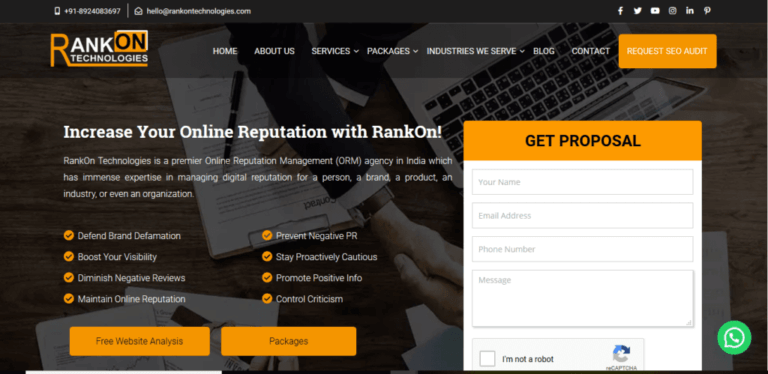Are you looking for a NGO website design service? RankON Technologies offers the best website design and development services for NGO. Contact us today for best NGO website design services.
Table of Contents
You Care for Society and We Care for Your NGO Website Design!

Importance of Designing a Website for NGO
Website design plays a crucial role in the success of NGOs for several reasons:
- Creating a strong online presence: A well-designed website helps NGOs establish a professional and credible online presence. It serves as a central hub for information about the organization, its mission, programs, and achievements. A visually appealing and user-friendly website can attract visitors and encourage them to engage with the NGO’s cause.
- Effective communication: NGOs need to effectively communicate their mission, goals, and impact to various stakeholders, including donors, volunteers, beneficiaries, and the general public. A thoughtfully designed website enables NGOs to convey their message clearly and compellingly. It can feature engaging storytelling, impactful visuals, and interactive elements to effectively communicate the organization’s work.
- Building trust and credibility: A well-designed website helps establish trust and credibility among potential donors, partners, and volunteers. A professional and visually appealing website creates a positive first impression and signals that the NGO is legitimate and reliable. It can showcase the organization’s achievements, testimonials, and impact stories, reinforcing its credibility and encouraging support.
- Engaging and mobilizing stakeholders: NGOs rely on engaging their stakeholders, including donors, volunteers, and supporters, to drive their mission forward. A website can facilitate this engagement by providing various interactive features such as donation forms, volunteer sign-ups, event registrations, and social media integration. An intuitive and user-friendly design makes it easier for stakeholders to take action and get involved.
- Information dissemination: NGOs often need to share valuable information, resources, reports, and updates with their audience. A well-designed website makes it easier to organize and present this information in a structured and accessible manner. Clear navigation, search functionality, and well-designed content layouts ensure that visitors can easily find and access the information they need.
- Fundraising and donor relations: Many NGOs rely on fundraising efforts to sustain their operations. A website can serve as a powerful fundraising tool by providing secure online donation options, showcasing fundraising campaigns, and highlighting the impact of donations. Effective website design can inspire and motivate visitors to contribute to the NGO’s cause.
- Accessibility and inclusivity: NGOs strive to reach a diverse audience, including individuals with disabilities. Website design should prioritize accessibility, ensuring that people with visual, auditory, or mobility impairments can access and navigate the website easily. This can include features such as text alternatives for images, keyboard navigation support, and captioning for videos.
In summary, website design is of paramount importance for NGOs as it helps establish credibility, communicate effectively, engage stakeholders, disseminate information, raise funds, and promote inclusivity. A well-designed website enhances the organization’s ability to achieve its mission and make a positive impact on society.
Understanding the target audience for NGO Website Design

To design an effective NGO website, it’s essential to understand the target audience and cater to their specific needs. The target audience for an NGO website can vary depending on the organization’s mission and goals.
Here are some key audiences to consider:
- Donors and Supporters: Donors and supporters are crucial for an NGO’s sustainability. The website should provide information about the organization’s impact, projects, and financial transparency. It should highlight donation options, showcase success stories, and communicate the importance of financial contributions. Clear calls-to-action and secure donation mechanisms are essential to engage and convert visitors into donors.
- Volunteers: NGOs often rely on volunteers who dedicate their time and skills to support the organization’s activities. The website should provide information on volunteer opportunities, requirements, and the impact of volunteering. It should have a user-friendly interface for volunteer sign-ups, allowing potential volunteers to easily express their interest and get involved.
- Beneficiaries and Community: NGOs work to serve specific communities or address particular issues. The website should provide relevant information, resources, and support for the target beneficiaries. It can feature success stories, testimonials, and case studies to demonstrate the organization’s impact. Language, cultural sensitivity, and accessibility should be considered to ensure the website is inclusive and helpful to the target community.
- Media and Press: NGOs often collaborate with the media to raise awareness about their cause and activities. The website should provide a dedicated media section with press releases, news updates, downloadable media kits, and contact information for media inquiries. High-quality images, videos, and impactful stories can help engage the media and facilitate coverage of the organization’s work.
- Partners and Collaborators: NGOs may collaborate with other organizations, governments, or corporations to achieve their goals. The website should highlight partnerships, showcase collaborative projects, and provide information for potential partners. It can include sections on partnership opportunities, collaboration success stories, and contact information for partnership inquiries.
- General Public and Awareness: The website should engage the general public, raising awareness about the NGO’s mission, cause, and impact. It should provide educational content, infographics, and videos to explain the issues the NGO addresses and why they matter. It can offer opportunities for visitors to sign up for newsletters, follow the organization on social media, and stay informed about upcoming events or campaigns.
Understanding the target audience helps in tailoring the website’s design, content, and functionality to their specific needs and preferences. Conducting user research, surveys, and feedback analysis can provide valuable insights into the audience’s expectations and preferences, ensuring the website effectively engages and serves its intended users.
Identifying potential donors and volunteers for NGO Website Design
Identifying potential donors and volunteers for your NGO website design requires a strategic approach.
Here are some steps to help you identify and engage with potential donors and volunteers:
- Define your target audience: Start by clearly defining your target audience for donors and volunteers. Consider demographics such as age, location, interests, and skills. This will help you tailor your website design and messaging to appeal to your specific audience.
- Conduct audience research: Conduct research to identify potential donors and volunteers who align with your organization’s mission and goals. This can include analyzing your existing donor and volunteer database, surveying your current supporters, and exploring online communities or platforms relevant to your cause. This research will help you understand the characteristics and preferences of your target audience.
- Create donor and volunteer personas: Based on your audience research, create donor and volunteer personas. These personas represent fictional individuals who embody the characteristics of your target audience. Develop detailed profiles that include their motivations, preferences, challenges, and goals. This will enable you to design your website with specific personas in mind, ensuring your messaging and design elements resonate with them.
- Craft compelling messaging: Develop compelling messaging that speaks directly to your target audience’s interests and motivations. Clearly communicate the impact of your organization’s work and how donors and volunteers can contribute to that impact. Use persuasive language, emotional storytelling, and concrete examples to engage your audience and inspire action.
- Highlight success stories and testimonials: Showcase success stories, testimonials, and case studies on your website. Feature stories that highlight the impact of your organization’s work on individuals or communities. These stories can serve as powerful testimonials to attract both donors and volunteers, as they demonstrate the tangible results of their support.
- Incorporate clear calls-to-action: Ensure your website incorporates clear and prominent calls-to-action (CTAs) for both donors and volunteers. CTAs should be strategically placed throughout your website and guide visitors to take the desired action, whether it’s making a donation or signing up as a volunteer. Use visually appealing buttons, compelling language, and easy-to-follow steps to encourage engagement.
- Provide easy-to-use forms and sign-up processes: Simplify the donation process and volunteer sign-up processes on your website. Provide user-friendly forms that are intuitive and require minimal effort to complete. Make it easy for potential donors to choose their preferred donation method and provide multiple options for secure online payments. For volunteers, create a simple registration form that collects the necessary information without being overwhelming.
- Leverage social media and email marketing: Integrate your website with social media platforms and use email marketing campaigns to reach potential donors and volunteers. Promote your website through social media channels and encourage sharing of your content. Regularly communicate with your email subscribers, sharing updates, impact stories, and volunteer opportunities to keep them engaged.
- Engage with the community: Actively engage with your target audience through various channels. Participate in relevant events, forums, and online communities to establish connections and raise awareness about your organization. Collaborate with influencers, partner organizations, and local businesses to expand your reach and attract potential donors and volunteers.
Creating a user-friendly interface For NGO Website Design

Creating a user-friendly interface for your NGO website is essential to ensure a positive user experience and encourage engagement.
Here are some key principles and tips to help you design a user-friendly interface:
- Clear and intuitive navigation: Design a clear and intuitive navigation menu that is easy to understand and navigate. Use standard navigation conventions, such as a top or side menu, and organize your content logically. Limit the number of menu items to avoid overwhelming users, and ensure that important sections are easily accessible.
- Responsive design: Ensure your website is responsive and adapts to different devices and screen sizes. This is crucial as many users access websites from mobile devices. Responsive design ensures that your website is user-friendly and visually appealing on desktops, tablets, and smartphones.
- Consistent layout and design: Maintain consistency in layout, typography, and design elements throughout your website. Consistency helps users navigate your site more easily and builds a sense of familiarity. Use a grid system to maintain alignment and balance, and choose a visually pleasing color scheme that reflects your NGO’s branding.
- Readability and legibility: Use clear and legible fonts with appropriate font sizes to enhance readability. Ensure there is enough contrast between the text and the background to make it easy for users to read. Avoid using excessive decorative fonts that may be difficult to read. Break up content into paragraphs and use headings and subheadings to create a visual hierarchy and aid scanning.
- Limited use of animations and effects: While animations and effects can add visual interest, use them judiciously to avoid overwhelming the user or slowing down the website. Focus on enhancing the user experience rather than using animations for the sake of aesthetics. Use smooth transitions and subtle effects to guide users’ attention or provide feedback.
- Clear and concise content: Craft clear and concise content that is easy to understand. Use plain language and avoid jargon or technical terms whenever possible. Break up content into easily digestible sections with headings, bullet points, and numbered lists. Use visuals, such as images and infographics, to support the content and make it more engaging.
- Minimize load times: Optimize your website to load quickly to avoid user frustration. Compress images, minimize the use of large multimedia files, and utilize caching techniques. Test your website’s performance regularly and make improvements to optimize loading times.
- User-friendly forms: If your website includes forms for donations, volunteer sign-ups, or contact, ensure they are user-friendly. Keep the form fields to a minimum, only requesting essential information. Use clear labels and provide helpful instructions. Use validation to assist users in filling out the form correctly and provide confirmation messages upon successful submission.
- Accessibility considerations: Ensure your website is accessible to users with disabilities. Follow web accessibility guidelines, such as providing alt tags for images, ensuring proper color contrast, and designing for keyboard navigation. Test your website with accessibility tools and consider involving users with disabilities in user testing to identify any barriers and make necessary improvements.
- User testing and feedback: Conduct user testing to gather feedback and identify usability issues. Observe how users interact with your website, take note of any difficulties they encounter, and make necessary adjustments based on their feedback. Incorporate user feedback into the iterative design process to continually improve the user experience.
Simplifying navigation and content display for NGO Website Design
Simplifying navigation and content display is crucial for an NGO website to ensure that visitors can easily find the information they need and engage with your organization.
Here are some strategies to simplify navigation and content display for an effective NGO website design:
- Streamline the navigation menu: Keep the navigation menu simple and concise. Limit the number of menu items to the most essential sections to avoid overwhelming visitors. Categorize and group related pages or content under broader menu headings to create a logical hierarchy. Use clear and descriptive labels for each menu item.
- Use a hierarchical structure: Organize your content in a hierarchical structure to make it easier for visitors to navigate through different sections of your website. Use parent pages and child pages to create a clear and logical flow of information. Consider using dropdown menus or expandable/collapsible sections to display subcategories or additional content without cluttering the main navigation.
- Implement a search function: Include a search bar prominently on your website to allow visitors to quickly search for specific information. Make sure the search function is easily accessible from every page. Use predictive search or auto-complete features to assist users in finding relevant content.
- Prioritize important information: Highlight the most critical information or actions on your website to ensure they are easily noticeable. Use clear headings, bullet points, or call-out boxes to draw attention to key messages, upcoming events, or donation opportunities. Consider placing important content above the fold, so it’s visible without scrolling.
- Break up content with headings and sections: Break up longer blocks of content into smaller sections using headings, subheadings, and bullet points. This helps users scan the content quickly and locate the information they are looking for. Use descriptive headings that accurately summarize the content in each section.
- Utilize visual elements: Incorporate visuals such as images, icons, and infographics to enhance the display of content and make it more engaging. Visuals can convey information more effectively and break up text-heavy pages. However, use visuals judiciously to avoid overwhelming the page or slowing down load times.
- Implement collapsible sections: For content-heavy pages, consider using collapsible sections or accordions to display additional information. This allows visitors to expand or collapse sections based on their interest, reducing clutter and improving the overall user experience. Use clear labels and icons to indicate expandable sections.
- Provide clear calls-to-action (CTAs): Use clear and prominent CTAs to guide visitors to take desired actions such as donating, volunteering, or subscribing to newsletters. Use contrasting colors, appropriate placement, and concise messaging to make the CTAs stand out. Ensure that the CTAs are easily clickable and lead to the intended destination.
- Optimize for mobile devices: As a significant portion of website traffic comes from mobile devices, ensure your website is mobile-friendly. Implement responsive design techniques to provide a seamless experience across different screen sizes. Simplify the navigation menu for mobile devices, use legible font sizes, and ensure buttons and forms are easy to tap and fill out.
- Test and gather feedback: Conduct user testing to evaluate the effectiveness of your website’s navigation and content display. Observe how users interact with the site, identify any pain points or confusion, and make necessary improvements based on user feedback. Regularly gather feedback from users, volunteers, and donors to continuously refine and simplify your website’s design.
Telling compelling stories through visuals for NGO Web Design
Telling compelling stories through visuals is a powerful way to engage and connect with your audience. Visuals have the ability to evoke emotions, convey information, and leave a lasting impact.
Here are some strategies to effectively tell compelling stories through visuals on your NGO website:
- Choose impactful images: Select high-quality images that capture the essence of your organization’s mission and the people you serve. Use images that evoke emotions and visually communicate the story you want to tell. Show real people and real situations to make the stories relatable and authentic. Use diverse images to represent the diversity of your beneficiaries and the communities you work with.
- Incorporate multimedia elements: Don’t limit yourself to just static images. Incorporate videos, slideshows, and interactive elements to create a dynamic and immersive storytelling experience. Use videos to showcase success stories, interviews, or behind-the-scenes footage. Combine visuals with audio to create a multi-sensory experience that resonates with your audience.
- Infographics and data visualization: Use infographics and data visualization to present complex information in a visually appealing and easy-to-understand format. Visualize statistics, impact metrics, and achievements to communicate the scale and effectiveness of your organization’s work. Infographics can be used to highlight key facts, process explanations, or comparative data, making it easier for your audience to grasp the information quickly.
- Before-and-after visuals: If applicable to your work, use before-and-after visuals to demonstrate the transformation or impact your organization has made. Show the initial conditions or challenges faced by your beneficiaries and juxtapose them with visuals showcasing the positive changes brought about by your interventions. This helps your audience understand the tangible difference your organization is making.
- User-generated content: Encourage your supporters, beneficiaries, and volunteers to share their stories and visuals related to your organization’s work. User-generated content adds authenticity and a personal touch to your storytelling. Feature user-submitted photos, videos, or testimonials on your website to showcase the impact your organization has on individuals and communities.
- Captions and storytelling captions: Complement your visuals with compelling captions that provide context and enhance the storytelling. Captions can explain the significance of the visual, provide background information, or share personal narratives. Use concise and engaging language to captivate your audience and make them feel connected to the story being told.
- Visual consistency and branding: Maintain visual consistency throughout your website to create a cohesive storytelling experience. Use consistent colors, fonts, and design elements that align with your NGO’s branding. This consistency helps build recognition and strengthens the overall impact of your visual storytelling.
- Emotional storytelling: Connect with your audience on an emotional level by focusing on personal stories that tug at the heartstrings. Use visuals to showcase the challenges faced by your beneficiaries, their resilience, and the positive outcomes they achieve with your organization’s support. Make your audience feel a sense of empathy, compassion, and the desire to take action.
- Interactive storytelling: Engage your audience through interactive storytelling experiences. Use interactive features such as quizzes, interactive maps, or storytelling timelines to enable visitors to explore and engage with your organization’s work at their own pace. This interactive approach allows users to dive deeper into specific aspects of your story and encourages active participation.
- Test and iterate: Continuously test and gather feedback on the effectiveness of your visual storytelling. Monitor analytics, conduct user surveys, and seek input from your target audience to understand how well your visuals resonate with them. Based on the feedback received, make improvements, refine your storytelling techniques, and adapt your visuals to create a more impactful and engaging experience.
Using images and videos to engage visitors for NGO Web Design
Using images and videos effectively is crucial for engaging visitors on your NGO website.
Here are some tips to make the most of images and videos:
- Choose compelling visuals: Select high-quality images and videos that are visually appealing and align with your organization’s mission. Use images and videos that evoke emotions, tell stories, and capture the attention of your visitors. Show real people and real situations to create a personal connection.
- Feature impactful visuals prominently: Place your most impactful visuals in prominent positions on your website. Use them as banners or hero images on your homepage to immediately grab visitors’ attention. Consider using sliders or carousels to showcase multiple visuals and capture different aspects of your work.
- Tell a story with visuals: Use images and videos to tell a story. Capture the journey of your beneficiaries, highlight the impact of your projects, and showcase the positive changes brought about by your organization. Arrange visuals in a sequential manner to guide visitors through a narrative, using captions or accompanying text to provide context and enhance the storytelling.
- Keep load times in mind: Optimize your images and videos to ensure fast loading times. Compress images without compromising quality to reduce file sizes. Host videos on reputable video platforms (such as YouTube or Vimeo) and embed them on your website. This helps reduce the strain on your server and ensures smooth playback.
- Use captions and descriptions: Provide captions or descriptions for your images and videos to provide context and enhance understanding. Use concise and compelling language to convey the key message of each visual. Captions can help reinforce the story you’re telling and encourage visitors to engage further with your content.
- Incorporate user-generated content: Encourage your supporters, volunteers, and beneficiaries to submit their own images or videos related to your organization’s work. User-generated content adds authenticity and diversity to your website. Display these visuals on dedicated sections or galleries, giving credit to the contributors and sharing their stories.
- Utilize video testimonials: Video testimonials from beneficiaries, volunteers, or donors can have a powerful impact on your website visitors. Showcasing firsthand accounts of the impact your organization has made adds credibility and emotional connection. Ensure the testimonials are well-produced, concise, and compelling.
- Include interactive elements: Make your visuals interactive to engage visitors actively. For example, you can use clickable hotspots on images to provide additional information or create image sliders that allow users to compare before and after images. Interactive elements encourage exploration and increase visitor engagement.
- Use visuals for calls-to-action: Images and videos can be effective in driving specific actions. Use visuals strategically to guide visitors towards desired actions, such as donating, volunteering, or signing up for newsletters. Incorporate visual elements, such as buttons or overlays, to draw attention and encourage click-throughs.
- Test and analyze: Regularly monitor the performance of your visuals using analytics tools. Track metrics such as engagement rates, click-through rates, and conversion rates to understand which visuals are resonating with your audience. Use this data to make informed decisions and optimize your visuals for better engagement.
Remember, visuals should complement your website’s content and work in harmony with your messaging. They should evoke emotions, tell stories, and ultimately inspire visitors to take action and support your NGO’s mission.
Incorporating calls-to-action effectively for NGO Website Development
Incorporating calls-to-action (CTAs) effectively is essential for guiding visitors to take specific actions on your NGO website.
Here are some tips for incorporating CTAs effectively in your website development:
- Clear and prominent placement: Make sure your CTAs are easily visible and stand out on your webpages. Place them in strategic locations, such as the header, sidebar, or above the fold, where visitors can easily spot them without scrolling. Use contrasting colors, larger font sizes, or buttons to draw attention to the CTAs.
- Use concise and action-oriented language: Craft clear and concise CTA copy that conveys the action you want visitors to take. Use action verbs and persuasive language that encourages immediate engagement. For example, instead of using generic phrases like “Click here,” use specific and compelling CTAs like “Donate now to make a difference” or “Join our volunteer team today.”
- Create a sense of urgency: Encourage immediate action by creating a sense of urgency in your CTAs. Use words or phrases that convey a limited time or opportunity, such as “Donate before time runs out” or “Limited spots available, sign up now.” Incorporate countdown timers or expiration dates for specific campaigns or fundraising goals to add urgency.
- Offer incentives: Provide an incentive or highlight the benefits of taking action to increase CTA effectiveness. For example, offer a free e-book, exclusive content, or a special discount for donors or volunteers. Clearly communicate the value or impact that the visitor can expect by engaging with your CTA.
- Tailor CTAs to specific goals: Customize CTAs based on specific goals you want to achieve. Whether it’s donating, volunteering, signing up for a newsletter, or joining a campaign, create specific CTAs for each objective. Use relevant imagery or icons to reinforce the purpose of the CTA and make it more visually appealing.
- Use multiple CTAs strategically: Incorporate multiple CTAs on your website, but avoid overwhelming visitors with too many options. Prioritize the primary CTA and place it prominently, while using secondary CTAs sparingly and in appropriate contexts. For example, have a primary CTA for donations and secondary CTAs for volunteering or subscribing to newsletters.
- Test and optimize: Continuously test and optimize your CTAs to maximize their effectiveness. Experiment with different colors, wording, placement, and design to see which variations generate the best response. A/B testing can help you determine which CTAs drive more conversions and engagement. Use analytics tools to track CTA performance and make data-driven decisions.
- Make CTAs mobile-friendly: Ensure your CTAs are easily clickable and accessible on mobile devices. Test the responsiveness of your CTAs across different screen sizes to ensure a seamless user experience. Use larger button sizes and provide enough spacing to prevent accidental clicks on mobile devices.
- Provide a seamless user journey: Ensure that your CTAs lead visitors to a relevant landing page or form where they can complete the desired action. The landing page should provide clear instructions, a streamlined process, and a continuation of the messaging from the CTA. Eliminate any unnecessary steps or barriers that may hinder conversion.
- Monitor and analyze results: Regularly monitor and analyze the performance of your CTAs. Track metrics such as click-through rates, conversion rates, and engagement levels to evaluate the effectiveness of your CTAs. Identify patterns and trends to refine your approach and make improvements for better results.
By incorporating effective CTAs, you can guide visitors to take action and actively engage with your NGO. Remember to align your CTAs with your organization’s goals, keep them clear and compelling, and continually optimize based on data and user feedback.
Encouraging donations, volunteering, or sharing on social media
Encouraging donations, volunteering, or sharing on social media are important actions for an NGO.
Here are some specific strategies for effectively promoting these actions on your website:
Donation CTAs:
- Highlight the impact of donations: Clearly communicate the difference donations can make by showcasing success stories, testimonials, or impact metrics. Use visuals and compelling narratives to evoke emotions and demonstrate the importance of financial support.
- Provide giving options: Offer different donation amounts and highlight the specific outcomes that each level of donation can achieve. Provide options for one-time donations, recurring donations, or specific campaigns to cater to different donor preferences.
- Show progress towards goals: Display progress bars or indicators that show how close you are to reaching your fundraising goals. This creates a sense of urgency and encourages visitors to contribute.
- Offer secure and convenient payment options: Provide a variety of secure payment methods to accommodate donor preferences. Clearly communicate the security measures in place to ensure trust and transparency.
Volunteer CTAs:
- Highlight the impact of volunteering: Share stories and testimonials from volunteers to showcase the value and rewards of volunteering. Explain how volunteers contribute to your organization’s mission and the difference they make in the lives of others.
- Provide clear instructions: Clearly outline the steps for becoming a volunteer, including any necessary forms, background checks, or training. Make it easy for visitors to understand the process and take the first steps towards volunteering.
- Showcase volunteer opportunities: Highlight specific volunteer roles, projects, or events that are available. Provide detailed descriptions, time commitments, and any required skills or qualifications. Make it easy for visitors to find and express interest in volunteer opportunities.
Social Media Sharing CTAs:
- Include social media sharing buttons: Integrate social media sharing buttons on your website to make it easy for visitors to share your content. Place these buttons near impactful stories, inspiring images, or campaign updates.
- Craft shareable content: Create compelling and share-worthy content that resonates with your audience. Develop engaging stories, infographics, or videos that communicate your mission and inspire others to share. Incorporate clear calls-to-action within the content to encourage sharing.
- Implement social media widgets: Display real-time social media feeds or testimonials on your website to showcase the positive engagement and impact of your organization’s work. This demonstrates social proof and encourages visitors to follow and share your content.
Recognition and gratitude:
- Express appreciation: Thank donors, volunteers, and social media sharers for their support and contributions. Acknowledge their impact and show gratitude through personalized thank-you messages, emails, or shout-outs on your website or social media platforms.
- Share success stories: Highlight the outcomes and achievements made possible by the support of donors and volunteers. Showcase how their contributions have made a difference and inspire others to get involved.
Clear and compelling messaging:
- Use persuasive language: Craft compelling and persuasive messaging throughout your website to encourage visitors to take action. Clearly articulate the benefits and impact of donations, volunteering, or social media sharing.
- Create a sense of urgency: Communicate the urgency of the cause and the immediate need for support. Use time-limited campaigns, upcoming events, or specific funding goals to create a sense of urgency and motivate action.
Remember to continually optimize and test your CTAs, messaging, and content to maximize engagement and conversion rates. Regularly evaluate the performance of your strategies through analytics and user feedback, and make adjustments accordingly. By effectively promoting donations, volunteering, and social media sharing, you can inspire visitors to actively support and engage with your NGO.
Ensuring mobile responsiveness for NGO Website Design
Ensuring mobile responsiveness is crucial for NGO website design, as an increasing number of users access websites from mobile devices.
Here are some important considerations to ensure your NGO website is mobile-friendly:
- Responsive design: Use a responsive website design approach, which automatically adapts the layout and content of your website to fit different screen sizes and devices. This ensures a consistent and optimized user experience across desktops, tablets, and smartphones.
- Mobile-first approach: Prioritize the mobile user experience during the design process. Start by designing for mobile devices first and then progressively enhance the layout and functionality for larger screens. This approach ensures that your website is optimized for mobile users who may have limited screen space and slower internet connections.
- Simplify navigation: Optimize your navigation menu for mobile devices by using collapsible or hamburger menus. This allows users to easily access different sections of your website without taking up too much screen space. Ensure that the menu is intuitive and easy to use, with clear labels and organized sections.
- Clear and concise content: Streamline your content for mobile devices by keeping it concise and focused. Break up lengthy paragraphs into smaller sections, use subheadings to improve scannability, and utilize bullet points or lists to make information more digestible. Ensure that fonts are legible and large enough to read on smaller screens.
- Mobile-friendly forms: If your website includes forms for donations, volunteering, or contacting your organization, make sure they are mobile-friendly. Optimize form fields and buttons for touchscreen use, minimize the number of required fields, and use auto-fill options where possible to streamline the input process. Test forms on different mobile devices to ensure a smooth user experience.
- Optimized media content: Optimize images, videos, and other media elements for mobile devices to minimize loading times and data usage. Compress images to reduce file sizes without sacrificing quality, and consider using responsive video players that adapt to different screen sizes. Ensure that media content is properly scaled and doesn’t disrupt the overall layout.
- Touch-friendly buttons and links: Ensure that buttons and links on your website are large enough and have enough spacing to be easily tapped with a finger on a touchscreen device. Avoid placing interactive elements too close together to prevent accidental clicks. Use visual cues, such as contrasting colors or hover effects, to indicate interactive elements.
- Performance optimization: Mobile users may have slower internet connections or limited data plans, so optimize your website’s performance to minimize load times. Compress and optimize code, leverage browser caching, and minimize the use of heavy scripts or plugins. Regularly test your website’s performance on mobile devices and make necessary optimizations.
- Cross-browser and device testing: Test your NGO website on various mobile devices, screen sizes, and browsers to ensure compatibility and a consistent experience across different platforms. Pay attention to different operating systems (iOS, Android) and popular mobile browsers (Chrome, Safari) to identify any layout or functionality issues.
- User testing and feedback: Gather feedback from actual mobile users to identify any usability issues or areas for improvement. Conduct user testing sessions or solicit feedback through surveys to understand how visitors interact with your mobile website and make adjustments based on their input.
By implementing these mobile responsiveness best practices, you can ensure that your NGO website delivers an optimal user experience on mobile devices, allowing users to access information, engage with your content, and take action seamlessly.
Making the NGO website Design accessible across different devices
Ensuring accessibility across different devices is crucial for the design of an NGO website.
Here are some important considerations to make your website accessible across various devices:
- Responsive design: As mentioned earlier, use a responsive design approach that adapts your website’s layout, content, and functionality to different screen sizes and devices. This ensures that users can access and interact with your website effectively, whether they are using desktops, tablets, or smartphones.
- Device compatibility testing: Test your website on different devices and screen sizes to ensure compatibility and a consistent experience. Consider popular devices, operating systems, and browsers used by your target audience. This testing helps identify any layout, functionality, or usability issues that may arise on specific devices.
- Scalable fonts and adjustable text size: Use scalable fonts and design your website with the ability for users to adjust the text size. This allows users with visual impairments or different device settings to comfortably read the content on your website. Avoid using fixed font sizes that may become too small or too large on certain devices.
- Clear and legible typography: Choose fonts that are easily readable across different devices and screen sizes. Use appropriate font sizes, line spacing, and contrast to ensure legibility, especially for mobile users who may be viewing your website on smaller screens.
- Consistent navigation and layout: Maintain a consistent navigation structure and layout across different devices to provide a familiar experience to users. Ensure that menus, buttons, and interactive elements are easily accessible and have enough spacing for touch interaction on mobile devices.
- Keyboard accessibility: Design your website to be easily navigable using a keyboard, as some users may have motor impairments or prefer keyboard navigation. Ensure that all interactive elements can be accessed and activated using keyboard inputs alone. Avoid relying solely on mouse or touch interactions.
- Alternative text for images: Provide descriptive alternative text (alt text) for images on your website. This allows users with visual impairments who use screen readers or assistive technologies to understand the content and purpose of the images. Alt text should convey the meaning and context of the image concisely.
- Captioning and transcripts for multimedia: If your website includes videos or audio content, provide captions or transcripts to make the content accessible to users with hearing impairments or those who cannot play media with sound. Ensure that the captions or transcripts are accurate and synchronized with the multimedia content.
- Color contrast and visual indicators: Use sufficient color contrast between text and background to ensure readability for users with visual impairments. Avoid relying solely on color to convey information, and use additional visual indicators such as icons or patterns to communicate important messages.
- Accessibility testing and compliance: Regularly conduct accessibility testing using tools and guidelines, such as the Web Content Accessibility Guidelines (WCAG). These tests help identify accessibility issues and ensure that your website meets the required accessibility standards. Consider involving users with disabilities in the testing process to gain valuable insights.
By following these accessibility considerations and best practices, you can make your NGO website design inclusive and accessible across different devices. Creating a website that is accessible to all users ensures that everyone can access your content, engage with your organization, and contribute to your mission.
Want to build an NGO Website for your Organization? Must Contact Us!
RankON Technologies is a trusted website development company that offers complete website design and development services for all types of businesses and organizations.
Must check our website development packages now!
Get in Touch!Check our Web Development Packages











